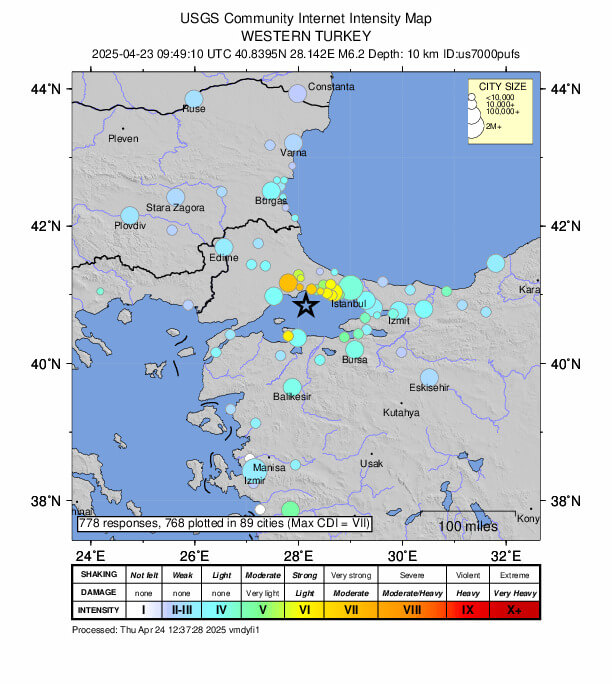
Image Credit: United States Geological Survey / Wikimedia Commons
A recent news report from Reuters said that a powerful 6.2 magnitude earthquake struck Istanbul on April 23 on the European side of the city. While there were no reports of fatalities or major structural damage, over 151 people were injured as they panicked and jumped from the building.
“They are receiving treatment at the hospital and none of them are in critical condition,” the Istanbul governor’s office said in a statement quoted by Reuters.
Turkey’s largest city Istanbul, sits just 20 kilometres from the North Anatolian Fault (NAF) line which is one of the most active and dangerous fault lines globally.
In the same report, Reuters referenced the devastating twin earthquakes of 2023 in southern Turkey and Syria, which killed more than 55,000 people and injured over hundreds of thousands of people.
Earthquake researcher Naci Görür has sounded the alarm over Istanbul’s vulnerability to a major earthquake, warning that up to 100,000 structures in the city are at risk of collapsing. In the news report by The Munich Eye, he stressed that unless urgent steps are taken to boost preparedness, the consequences could be disastrous, not only in terms of human casualties but also for the city’s economy.
Many buildings in Istanbul cannot withstand a devastating earthquake, including both commercial and residential buildings. The high population of the city along with no effective preventive measures to tackle the earthquake might result in more severe damage to human lives than we could have imagined.
The Istanbul earthquake also adds to growing concerns about urban resilience in hazard-prone cities worldwide. It raises the question that “How resilient are the world’s major cities to disasters” ?
Cities such as Tokyo, Jakarta, and Manila are widely recognised as hazard-prone zones and face disasters of some form like Earthquakes, Sea Level Rise, etc. Some cities have implemented proactive strategies. Tokyo, for example, has developed robust building codes and emergency systems to mitigate its seismic risk. Others, like Jakarta and Manila, continue to struggle with unplanned urban sprawl and inadequate disaster preparedness.
In terms of emergency preparedness, Istanbul does not have a citywide early warning system like Tokyo. Also in tokyo, earthquake resilience is not just a policy, but it is in their culture. Japan invests a good chunk of money into seismic safety with strict building codes enforced since the 1980s and it gets updated after every major earthquake.
However, the Istanbul government understood the gravity of this issue and decided to take some measures after the 2023 earthquake. Following the 2023 earthquake, Istanbul Mayor Ekrem İmamoğlu introduced the city’s new “Roadmap for Disaster Preparedness,” as highlighted in a CNN article.
According to this plan, a greater amount of money from the city funds will be used in the disaster preparedness program and especially the city will prioritise the rapid scanning system to assess the safety of Istanbul’s buildings, reported by CNN in the same article.
Despite taking these measures, many specialists are saying that Istanbul is still ill-equipped to handle a severe seismic event in future. In fact, Geology professor Sükrü Ersoy from Yildiz Technical University said that many buildings are not disaster-resistant yet, as reported by The Munich Eye.
